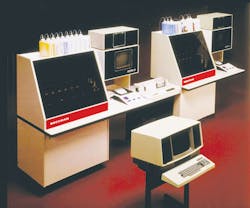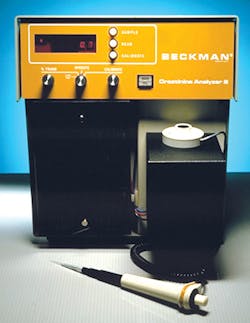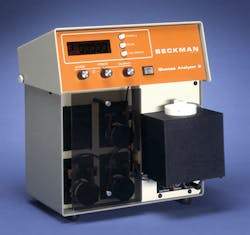Chemistry analyzers’ advancing technology offers increased testing capabilities
CONTINUING EDUCATION
To earn CEUs, visit www.mlo-online.com under the CE Tests tab.LEARNING OBJECTIVES
1. Describe the history of clinical chemistry systems upon the emergence of modern clinical chemistry in the 1900s, and list the basic tests.
2. Discuss the rise of automation and what technological advancements brought to that era in clinical chemistry.
3. Explain how trends in healthcare have shaped the functionality and design of analyzers.
4. Discuss what future advancements in chemistry analyzers may achieve.
Clinical chemistry has been defined as the branch of medicine that is focused on analyzing biological matter or body fluids to deliver timely, relevant, and precise diagnostic information about the clinical condition of the human body.1 While this merging of chemistry with medicine has been traced back thousands of years, the field of modern clinical chemistry, as it is known today, emerged in the early 1900s.2 As late as the early 1960s, most laboratories consisted of small enterprises in which technologists performed only a handful of manual tests, including glucose, urea, creatinine, electrolytes, cholesterol, basic enzymes, total protein, and albumin/globulin.3
These tests remain as some of the cornerstones of clinical chemistry today; however, the manner in which testing is performed has evolved substantially. Driven by a number of factors—including technological advancements and industry changes—clinical chemistry has grown to include large, integrated, and automated laboratories with sophisticated instrumentation that can perform hundreds to thousands of tests per hour.
History of clinical chemistry
The twentieth century became the age of modern clinical chemistry, with Harvard biochemist Otto Folin (1867-1934) more or less establishing clinical biochemistry in the United States. It was during the first decades of the century that blood and urine were first measured using quantitative analysis and instrumentation, and the results applied to human disease and health.2 What might be called the Golden Age of Clinical Chemistry began during the years after World War II. Between 1948 and 1960, such products as radioimmunoassay and the autoanalyzer were introduced.4 The latter ushered in the broad use of batch analyzers. Although many measured only one analyte, they enabled the testing of up to 100 samples at a time in continuous mode.5
Photoelectric colorimeters, having been introduced in 1939,6 also came into widespread use during this time. The standard then was visual colorimetry. It was believed that using photocells to measure light intensity would provide greater reliability than analysis by the human eye.6 During the 1960s, the combination of the autoanalyzer and photometer eventually replaced the visual colorimeter.4
The rise of automation
Several years later, the advent of computer- or microprocessor-based technology and software programming ushered in a new era for diagnostic testing—one that would eventually lead to automated environments that would enable laboratories to perform fast, high-quality testing and gain workflow efficiencies. In the days of early computer development, however, most chemistry tests still involved manual analysis. Many procedures relied on a process in which chemical reagents were mixed together, with the output being measured using a spectrophotometer.
Mid-decade, a number of technological advancements were introduced; these included instruments dedicated to a single or dual test menu, such as the flame photometer, and the chloride/CO2 and glucose analyzers. In 1978, the ASTRA (automated STAT routine analyzer) was introduced. This analyzer’s microprocessor-driven design enabled processing of seven of the most-commonly ordered STAT tests—sodium, potassium, chloride, CO2, glucose, BUN, and creatinine—in one minute using one consolidated system. Performing these same tests prior to the introduction of this platform normally would have taken 10 to 20 minutes. It also helped to bring to bringing automated pipetting to the industry.3
In the succeeding decades, the industry has witnessed a fast-evolving series of technological advancements in clinical chemistry instrumentation. With each new system generation, novel features have been introduced—such as closed tube sampling, automated maintenance processes, streamlined calibration, and internet-based remote diagnostics—all of which are intended to help laboratories better meet the needs of physicians and patients, while creating efficiencies, driving quality, lowering costs and addressing fluctuations in the workforce.
Today’s analyzers
Improvements in analyzer design and performance continue to be driven by a number of factors: technological breakthroughs, enhanced manufacturing practices, the integration of software into the lab environment, and medical discovery. In addition, changes in the reimbursement landscape and user needs have spurred the development of systems that feature flexibility and performance that far surpass their predecessors.
Technological breakthroughs. Computer technology has transformed clinical chemistry in two overarching areas: automation and informatics. Automation has touched every facet of clinical laboratory operations, enabling increased throughput to accommodate higher testing volumes; elevating quality by reducing human error and lessening the risk of sample cross-contamination; enhancing safety by reducing exposure to biohazardous materials; and improving workflow through greater system uptime and walkaway times.
Today, laboratories operate with greater efficiency than ever before. Processes that were, in the past, performed manually, now are performed via instrumentation. Full automation of pre-analytical, analytical, and post-analytical tasks enables laboratories to perform more work using less labor and fewer resources. Similarly, computers and microprocessor technology have enabled the creation of smaller-footprint units that accommodate higher test volumes. Today’s consolidated systems typically perform hundreds of tests on one platform, whereas preceding systems required a number of dedicated instruments, each performing only a few selected tests.
Automation combined with cloud-based technology has helped laboratories streamline daily operations and better manage patient information—all of which has become increasingly important due to trends in the workforce that have resulted in personnel shortages. Automating routine responsibilities frees laboratorians to focus more on patient care and functions for which they are specifically educated and trained. A pivotal area in which laboratories have been able to improve uptime and avoid unplanned costs is in automating inventory management. Cloud-based systems can help ensure timely ordering of reagents and consumables across an entire network, helping busy laboratories avoid workflow disruptions due to the potential inefficiencies resulting from manual inventory control processes.
In today’s world of Big Data, large amounts of information are available—but that can be more of a hindrance than a help to good practice if lab leaders do not manage the information effectively. Making that data relevant and usable for improving operations is important in helping laboratories achieve their continuous improvement goals. Today, lab directors need to coalesce actionable data into a single repository to drive decisions and provide valuable insights into laboratory performance network-wide. This can be accomplished via cloud-based analytics, and this will be increasingly important as the trend toward network consolidation continues to grow.
Enhanced manufacturing practices. Manufacturing practices have progressed alongside technological development. Throughout the 1800s and 1900s—from Eli Whitney’s cotton gin and interchangeable musket parts, to Henry Ford’s moving assembly line, to Walter Shewhart’s statistical quality control charts, to Motorola’s Six Sigma methods7—companies have sought to sustain a competitive advantage by improving quality and reducing errors. For the clinical lab, finding solutions to improve performance unachievable with technology alone has been key to attaining these goals. Such solutions include adopting Lean processes, forming strategic partnerships, and taking a “total laboratory” approach to operations. In the past, chemistry analyzers functioned as standalone workstations. Today, however, these systems are integral components of complex multifunctional operations that involve other disciplines, automated platforms, and information management tools.
Integration of software. Quality has long been a driver of design and development. Advancements in software have had a profound influence on processing in the laboratory. Evolutions in software have opened pathways for automation, which heightens consistency and reduces operator error, and for fast and accurate analysis, predictive analytics, and data interpretation, which help to ensure the highest quality of results.
Medical discoveries. Science has enabled an increasingly rich understanding of the human body and the diseases and disorders to which it is subject—and of the biomarkers that offer objective evidence of those diseases and disorders. For clinical chemistry, that means that new and novel assays for use in the diagnosis and management of various disease states are being constantly discovered and developed. As highly specialized assays continue to become a part of the standard of care, analyzer design must keep pace with the accompanying workload demands.
Evolving healthcare landscape. The healthcare industry has changed significantly in the past several decades. In the 1980s, some states introduced the concept of diagnostic related groups (DRGs)—a statistical system of classifying any inpatient stay into a specific group for the purpose of identifying appropriate reimbursement rates. This system would eventually have a significant effect on the clinical chemistry landscape, as physicians began to order only those tests for a specific condition that were approved according to the corresponding DRG.
In the late 1990s, the Health Care Financing Administration (the forerunner to the Centers for Medicare and Medicaid Services, or CMS, part of the U.S. Department of Health and Human Services) redefined chemistry panels—a group of individual chemistry tests—in terms of eligibility for government reimbursement. Again, this influenced how physicians ordered diagnostic tests. In 2007, CMS began to replace DRGs with “Medicare-severity DRGs” (ms-DRGs), designed to recognize complications and comorbidities.8
These and other legislative and regulatory factors—for example, some provisions of the Affordable Care Act, such as the carrot-and-stick of Meaningful Use—have influenced the modern laboratory, which is under increasing pressure to produce fast, accurate results while reducing costs. Most recently, the CMS’s controversial re-setting of reimbursement rates based on data collection processes that many laboratory stakeholders consider to be flawed has threatened the financial viability of some labs. In this context, manufacturers continue to work on technology solutions that will meet volume demands, produce precise results, and lower cost of ownership. Many of these solutions now involve creating reliable systems characterized by high throughput, maximized uptime, efficient reagent and energy usage, and simpler—yet sophisticated—mechanisms for easy maintenance.
The future of chemistry analyzers
Chemistry analyzers have come a long way during the last few decades, and the fast pace of technological development will fuel further technological enhancements. The drivers that affect development today will catalyze change in the future, accompanied by new, as yet unforeseen, drivers. It is anticipated that growth will be most robust in the areas of automation and software. Manufacturers will work to meet the laboratory’s need to manage increasing workloads with decreasing resources, simplifying labor-intensive tasks that are still performed manually today. Areas targeted for higher levels of automation will include instrument maintenance, system troubleshooting, and consumables management.
Software development initiatives will target workflow inefficiencies and results processing. Cloud-based systems and integrated networks will enable patient histories to be recorded and recalled, regardless of where testing is performed.
In addition to this, designers will continue the trend of downsizing units to reduce footprint, allowing more testing capabilities with smaller-sized machines. This will help laboratories save valuable space while still meeting the demands of physicians and patients. This will also pave the way for new technology in the area of point-of-care devices, reducing, for example, the need for large sample volumes.
Selecting a chemistry analyzer
Given all the benefits of modern instrumentation, the choice of an analyzer is not merely about the capabilities of the system. As with most technology, the choice should be based on user need. Laboratories must consider testing volume/throughput and the types of diagnostic tests that the system will perform. In addition, lab directors should think about the desired level of automation, as well as pre-analytical sample handling and post-analytical data management needs. Beyond instrumentation functionality, the laboratory must also examine space and cost constraints, taking into account footprint and system operating costs.
While choosing the right instrument is important to ensuring successful laboratory operations, it is only part of the equation. Laboratories today are looking for knowledgeable partners to help them apply proven continuous improvement strategies—borrowed from the manufacturing industry—to healthcare. A partner who is able to offer a total laboratory solution beyond instrumentation placement can help the laboratory to achieve its patient care and operational efficiency goals. This includes supporting the use of the instruments, identifying opportunities for automation, detecting workflow gaps, and helping to create efficiencies in managing resources.
Clinical chemistry has evolved greatly over time, driven by numerous factors—not the least being technological advancements in the world at large. Computers, microprocessors, and robotics paved the way for automation and cloud-based technology. With this, laboratories no longer consist of small standalone, manually operated units that performed a handful of tests; instead, they have transformed into bustling hubs featuring large integrated platforms that produced thousands of tests per hour with sophisticated information management systems. Future growth will build on this foundation, providing more capabilities in smaller-sized units. Instrumentation alone is only part of the equation. A strategic partnership can optimize laboratory performance, strengthening system advantages by integrating them into a total lab solution.
REFERENCES
- History of Clinical Chemistry, and Wöhler The Birth of Clinical Chemistry, Wilkinson I, eJIFCC vol 13 no 4. http://www.ifcc.org/ifccfiles/docs/130304003.pdf.
- Meites S. Otto Folin: America’s first clinical biochemist. In: Bernstein LH. The evolution of clinical chemistry in the 20th century. Leaders in Pharmaceutical Business Intelligence (LPBI) Group, BioMed e-Series; Medicine and Life Sciences Scientific Journal. https://pharmaceuticalintelligence.com/2014/12/13/the-evolution-of-clinical-chemistry-in-the-20th-century/.
- Kricka LJ, Savory J. A guide to the history of clinical chemistry. Clin Chem. 2011;57(8):1118-26.
- Rosenfeld L. A Golden Age of clinical chemistry: 1948-1960. Clin Chem. 2000;46(10):1705-1714.
- Armbruster DA. Clinical chemistry laboratory automation in the 21st century—amat victoria curam (victory loves careful preparation). Clin Biochem Rev. 2014; 35(3):143-53.
- National Museum of American History. Photoelectric Colorimeter. http://americanhistory.si.edu/collections/search/object/nmah_219.
- American Health Lawyers Association. Diagnosis-related group (DRG). https://www.healthlawyers.org/hlresources/Health%20Law%20Wiki/Diagnosis-related%20group%20(DRG).aspx
- Folaron J. The evolution of Six Sigma. Six Sigma Forum Magazine. 2003;2(4):38-44.
- American Health Lawyers Association. Diagnosis-related group (DRG). https://www.healthlawyers.org/hlresources/Health%20Law%20Wiki/Diagnosis-related%20group%20(DRG).aspx.
Steve Ishii serves as Senior Marketing Manager, Strategic Marketing, Global Chemistry for Beckman Coulter. He has worked for that company for 37 years, focused primarily on chemistry products.








